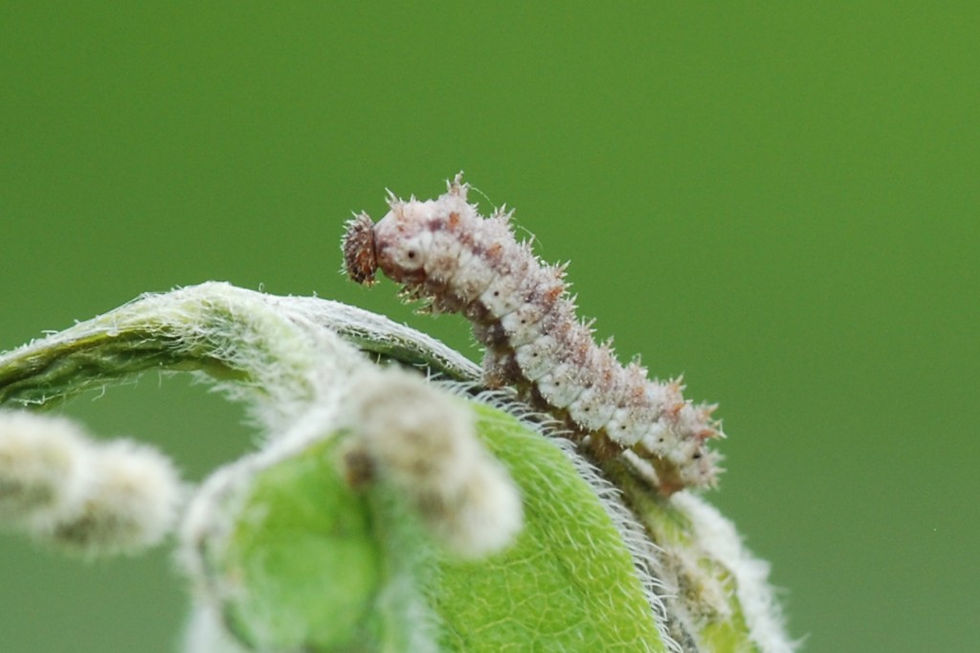
White Admiral
(Limenitis Camilla)
When this butterfly was called the White Admiral in the 18th Century it was an uncommon sight in the well-managed woods of England. However the mid-20th century saw a population explosion, and the White Admiral has spread out from the central counties of southern England into the West Country and Midlands. This expansion folllowed a series of warm summers in the 1930s and the neglect of coppice woodland where trees were once regularly trimmed and the undergrowth kept tidy. Neglect has allowed rampant growth of honeysuckle, the sole foodplant of the White Admiral's caterpillars.



Chrysalis is soft at first so that it is able to wriggle from the larval skin but soon begins to harden and darken for protection.

Chrysalis is soft at first so that it is able to wriggle from the larval skin but soon begins to harden and darken for protection.


The chrysalis is suspended from a small pad of orange silk attached to a stem or leaf.

The chrysalis is suspended from a small pad of orange silk attached to a stem or leaf.

The chrysalis is suspended from a small pad of orange silk attached to a stem or leaf.

The chrysalis is suspended from a small pad of orange silk attached to a stem or leaf.

The chrysalis is suspended from a small pad of orange silk attached to a stem or leaf.


The chrysalis is suspended from a small pad of orange silk attached to a stem or leaf.







Chrysalis begins to darken as butterfly develops.

Chrysalis begins to darken as butterfly develops.

Chrysalis begins to darken further, a couple of days prior to emergence as butterfly becomes increasingly developed.

Wings fully formed and visible prior to emergence.

Pupa (Chrysalis):
Ovum (Egg):




On a honeysuckle plant in Theberton Woods, Suffolk, July 2011

Larva (Caterpillar):



Young Caterpillar resting on midrib of Honeysuckle leaf, stripping the leaf on either side.





Larval Hibernaculum



Larval Hibernaculum









After emerging from hibernation, the caterpillar feeds from April until June.

After emerging from hibernation, the caterpillar feeds from April until June.

After emerging from hibernation, the caterpillar feeds from April until June.

After emerging from hibernation, the caterpillar feeds from April until June.

After emerging from hibernation, the caterpillar feeds from April until June.

After emerging from hibernation, the caterpillar feeds from April until June.

After emerging from hibernation, the caterpillar feeds from April until June.










Taken on May 12, 2007
![© Ken Dolbear [White Admiral larva]](https://static.wixstatic.com/media/6dead5_af0e567d587f4b229a254f3dc5c1f621.jpg/v1/fill/w_625,h_440,al_c,q_80,enc_avif,quality_auto/6dead5_af0e567d587f4b229a254f3dc5c1f621.jpg)








Imago (Adult):

'Basking on the gravel tracks'

Taken on July 3, 2011 in Northamptonshire

An adult feeds from a Bramble flower, a favourite nectar source. Linford Bottom, New Forest. 30.6.2011


An adult feeds from a Bramble flower, a favourite nectar source. Linford Bottom, New Forest. 30.6.2011

Dorset, UK.

Taken on July 2, 2006

Photographed in an ancient woodland in Ravensroost Wood, Near Minety, North Wiltshire, UK. 'Could still fly quite well' 19-8-2012
![© Dieter Seidendorf [Reared]](https://static.wixstatic.com/media/6dead5_d157c87041c040caadc9ef7a643d9c20.jpg/v1/fill/w_600,h_800,al_c,q_85,enc_avif,quality_auto/6dead5_d157c87041c040caadc9ef7a643d9c20.jpg)
Wings fully formed and visible prior to emergence.


© Josef Dvořák

© Josef Dvořák

© Josef Dvořák

© Josef Dvořák
![© Dieter Seidendorf [Reared]](https://static.wixstatic.com/media/6dead5_38785a5a937f42fa9a8f2404b911ce2f.jpg/v1/fill/w_600,h_800,al_c,q_85,enc_avif,quality_auto/6dead5_38785a5a937f42fa9a8f2404b911ce2f.jpg)
![© Dieter Seidendorf [Reared]](https://static.wixstatic.com/media/6dead5_304b7dd377284cc3bcfd82bec5225d37.jpg/v1/fill/w_600,h_800,al_c,q_85,enc_avif,quality_auto/6dead5_304b7dd377284cc3bcfd82bec5225d37.jpg)
![© Dieter Seidendorf [Reared]](https://static.wixstatic.com/media/6dead5_dbaf3710a2794f688c843ce5e7902e1d.jpg/v1/fill/w_800,h_600,al_c,q_85,enc_avif,quality_auto/6dead5_dbaf3710a2794f688c843ce5e7902e1d.jpg)
![© Dieter Seidendorf [Reared]](https://static.wixstatic.com/media/6dead5_02e8ca6396b64951ab884cd972e0aa36.jpg/v1/fill/w_600,h_800,al_c,q_85,enc_avif,quality_auto/6dead5_02e8ca6396b64951ab884cd972e0aa36.jpg)
![© Dieter Seidendorf [Reared]](https://static.wixstatic.com/media/6dead5_a5602325ae4f41d5a785db2c0ab9f368.jpg/v1/fill/w_980,h_654,al_c,q_85,usm_0.66_1.00_0.01,enc_avif,quality_auto/6dead5_a5602325ae4f41d5a785db2c0ab9f368.jpg)

© Josef Dvořák

© Josef Dvořák
Emergence:

Taken on March 27, 2012

Taken on March 27, 2012
Foodplants:
The butterflies gather in sunny, secluded pockets of woodland throughout July. The males establish territories by making repeated powerful flights around their patch , one moment swooping low over the vegetation, the next soaring up to perch high in the trees. Solitary females flutter around honeysuckle, looking for suitable egg-laying sites. The butterflies may live for four weeks, frequently visiting clumps of Brambles to drink nectar. By the end of the month their wings become torn and battered by thorns and a butterfly may end its life no longer able to take evading action from a predatory bird or dragonfly.
